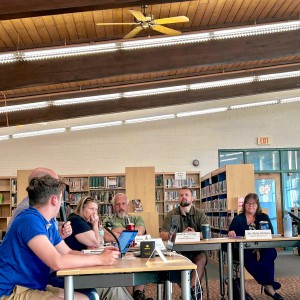A Marlborough science teacher takes on undiscovered ocean floor in exploration fellowship
| Published: 07-20-2023 12:07 PM |
Christopher Clauss, a Marlborough School science teacher, sets sail this week to aid other researchers in filling existing gaps in maps that trace the Eastern Pacific Ocean within and outside of the U.S. Exclusive Economic Zone.
Clauss will be aboard the Ocean Exploration Trust’s Exploration Vessel named Nautilus.
This is the second time Clauss, 49, of Chesterfield, has been chosen for the trust's Science Communication Fellowship. It's a professional development program that enables educators to take part in a deep sea oceanographic expedition and curate STEM-lessons or outreach material for students and audiences.
Clauss was first chosen in 2022 and spent four weeks on the Nautilus exploring seamounts in the Papahānaumokuākea Marine National Monument, a U.S. protected conservation site in the North Pacific Ocean.
Clauss will embark on the two-week-long voyage from Sidney, British Columbia, and will end it in Honolulu.
On this journey, Clauss and the others will map unexplored parts of the ocean, he said. This effort is part of Ocean Exploration Trust’s “ambitious” goal to map the entire world’s oceans by 2030, he added.
On the vessel, Clauss will serve as an expedition communicator, he said. Alongside a team of researchers, he will engage in research and help propagate it to learners all over the world during and after the voyage.
Clauss said the expedition will give him the opportunity to use his knowledge in science, which he acquired by serving as a science teacher for 25 years and as a student of marine biology at the University of New Hampshire.
Article continues after...
Yesterday's Most Read Articles
 Neighboring landowner objection stalls Steeplegate redevelopment approval
Neighboring landowner objection stalls Steeplegate redevelopment approval
 As N.H. coal-fired plants shift to solar, offshore wind beckons
As N.H. coal-fired plants shift to solar, offshore wind beckons
 Body of long-missing hiker found, pinned by boulder in Dry River
Body of long-missing hiker found, pinned by boulder in Dry River
 Baseball: Undermanned, Belmont battles against one of the state’s top pitchers
Baseball: Undermanned, Belmont battles against one of the state’s top pitchers
 UNH seeks vandal who accused university of genocide in spray-painted message
UNH seeks vandal who accused university of genocide in spray-painted message
 UNH Faculty Senate calls on university to investigate police response to protest
UNH Faculty Senate calls on university to investigate police response to protest
“I get to teach a lot of science, but this gives me the chance to go back into the field and do some of the things I was passionate about as a younger student, and really be at the forefront of some of the learning that we’re doing about our ocean,” Clauss said.
Clauss will aid in operating a multibeam sonar, which is a system that sends soundwaves to the bottom of the ocean. When the sonar bounces off the Eastern Pacific Ocean floor, the researchers will measure how fast those signals come back.
“We can tell exactly how far the bottom is from the ship. Instead of just doing a single ping to say, ‘how deep is it here?’ it does a fan, so it gets a broad selection of the floor,” Claus said, explaining how wide sonar beams are used to profile the ocean floor.
As the ship sails toward Honululu, Clauss said the mapping will be like taking an MRI scan by using a bunch of slices of the seafloor and putting them together. Aboard the ship, a computer will create a detailed 3D model, he said.
The research team will also be able to measure how deep the sediment layer is at the bottom of the ocean, he added.
“I feel like I’m going to the moon,” Clauss said. “Two miles below the surface, it’s a landscape unlike anything you could see in an aquarium or zoo. It’s a world of corals, sponges and invertebrate organisms.”
When Clauss first went on an expedition with the trust in 2022, he was able to Zoom call with his students from the ship.
Once Clauss is back from the expedition, he hopes to bring his students a deeper understanding of how marine science research is done.
While away, he would like to share his research process with any community groups, such as libraries and summer programs, by speaking to them live from the vessel.
All research work will be done remotely from the ship and will be streamed live at NautilusLive.org, where people can see live camera footage and sonar feeds from the Nautilus, Clauss said.
“We’re not in a coastal region in Cheshire County,” Clauss said. “And bringing the deep-sea environment right into classrooms can really help broaden students’ perspectives on the world and realize how connected they are to the ocean, even though they don’t live on it.”
These articles are being shared by partners in The Granite State News Collaborative. For more information visit collaborativenh.org.







 For the first time, education commissioner speaks publicly about minimum standards revision, but he faces skepticism
For the first time, education commissioner speaks publicly about minimum standards revision, but he faces skepticism Adam Montgomery sentenced to minimum 56 years on murder charges in young daughter’s death
Adam Montgomery sentenced to minimum 56 years on murder charges in young daughter’s death Following budget cut, Pembroke revisits future of elementary school re-build
Following budget cut, Pembroke revisits future of elementary school re-build
